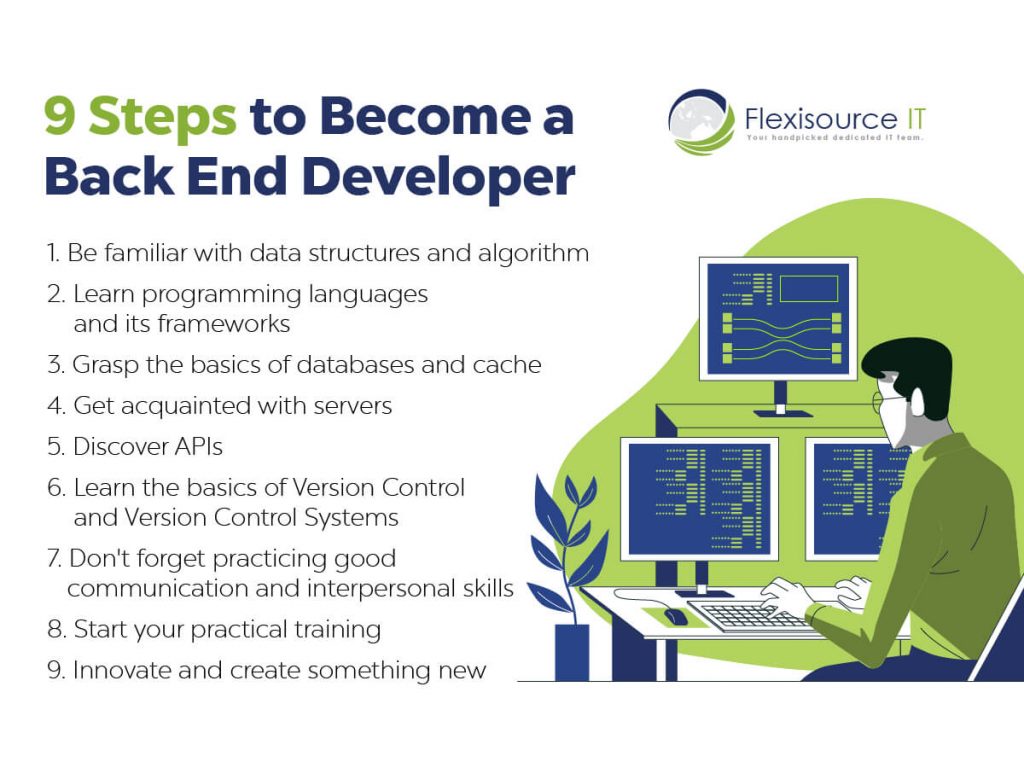A developer has built every piece of website and application that we encounter today. They are the professional who works behind the seen to ensure everything is running smoothly. These developers work hard to conduct vital tasks to sustain these websites and digital platforms for businesses to serve us better.
And one of these experts is Back End developers. Back End developers are in charge of the part of a website or application that most people do not see eye to eye. They ensure that the data you provide is stored safely and maintain the website’s stability in terms of hosting environment and putting logic in a website.
This article aims to tell readers what back-end developers do and show a guide on how to be a back-end developer.
Table of Contents
What do Back-end Developers Do?
Back-end developers are responsible for the server-side of a website or an application. They are in charge of creating a database, managing data, developing a web API, providing security to the website or app, and handling user authentication. In addition, some back-end developers sometimes oversee the Front End code creation that they will use to interact with their back-end code.
Likewise, Back-end developers use back-end developer languages such as PHP, Python, Ruby on Rails, ASP.NET MVC, NodeJS, etc., to build back-end applications.
Here are some other responsibilities of a back-end developer:
- Designing and implementing an API to store data in a database
- Creating a web service that allows users to authenticate themselves using the username and password credentials or OAuth tokens
- Creating scripts using programming languages like PHP, JavaScript, etc.
- Building database schema and handling data access requests from clients
- Ensuring that the website or app is secure
- Providing scalability for different devices
9 Steps in How to be a Back End Web Developer
Becoming a Back End Web Developer is not a walk in the park. Like any other profession, you need to take specific requirements and steps to be an expert. Here are nine steps on how to become a Back End Web Developer:

1. Be familiar with data structures and algorithms
Data structure and algorithm are probably essential steps of being a web developer that is often ignored and forgotten. Data structures and algorithms are the foundation of all programming. They are the building blocks for all programs, and without them, it is impossible to create a schedule.
Both data structure enables developers to organize and store data. At the same time, the algorithm allows developers to process the data in a meaningful way. In addition, a data structure is typically organized either in terms of how data is physically stored or how data logically relate. Likewise, an algorithm is a specific set of rules that developers follow when solving a problem or performing a task. Algorithms can be as simple as “add 1 + 1” or as complex as the steps required to execute a particular computer program.
2. Learn programming languages and their frameworks
As mentioned before, Back End Developers use programming languages to create the logic of a website. It powers everything from input forms, databases, and even search engines. In other words, it’s what makes your website work.
And this process is done by creating scripts executed on the server. These scripts are committed to processing data and then sending it to the user’s browser.
Likewise, probably another vital step on how to be a back-end developer is being well-versed in various popular programming languages. Here are some of the best stacks you can use in the back end.
- JavaScript
- Python
- C#
- Java
- SQL
- Ruby
3. Grasp the basics of databases and cache
Back-end developers are also responsible for setting up databases and maintaining caches to ensure that the site runs smoothly. Likewise, familiarity in both areas is vital for being a back-end developer.
Here is the difference between the two:
- A database assembles organized data so the program can effortlessly search, sort, and access very quickly.
- Caches are a temporary store used to reduce the server load by storing data in memory.
4. Get acquainted with servers
As mentioned earlier, Back End developers are responsible for storing and organizing data. And one tool that they need for these tasks is servers. Servers are required services across a network to keep a substantial number of files and data. Likewise, Back End developers should know servers well.
In addition, servers will help them when they need to deploy their API. Servers are the backbone of any API. Knowing how they work will make it easier for developers to build a scalable and secure API.
5. Discover APIs
Developing a back-end also needs to consider security and scalability. In this case, Back-end developers should know API because it is a set of tools that allow them to integrate their applications with other applications.
There are many use cases for API, but the most popular one is to provide an interface for third-party developers to access data from the company’s application.
6. Learn the basics of Version Control and Version Control Systems
Version Control is a computer software system that records changes in files, particularly source code. Developers can use it to maintain a history of changes, revert to an earlier version, and compare the differences between versions. On the other hand, Version Control Systems are programs that allow users to track updates and changes in sets of files.
Back-end Developers use both for their projects since it helps efficient collaboration on projects and reduces the need for backups or archiving older versions of files.
Likewise, one top skill of being a back-end developer is learning both version control and version control system to help them collaborate on code more efficiently and reduce the need for backups or archiving older versions of files.
7. Don’t forget to practice effective communication and interpersonal skills
As a back-end developer, you are often the one who interfaces with other teams and is responsible for developing and maintaining your company’s systems. As such, it’s essential to have some basic communication and interpersonal skills.
A respectable place to start is learning how to communicate effectively with people in your team. It means being able to understand their needs, challenges, and goals. It also means understanding what they want from you as a teammate – whether that be more clarity about your role or a better sense of how you can help them do their job better.
8. Start your practical training
You will not understand how stuff works in any profession until you start doing it practically.
And as a Back End Developer, you need to extensively use the tools and practice to understand ethical knowledge better. The best way to do this is by working on small projects or assignments. You can start by doing tasks like a simple To-do list, simple blog, photo gallery web app, resume builder, basic project management app, etc.
9. Innovate and create something new
While it is undeniable that back-end developers should know how to code, it is also significant to understand how to innovate. Back End development is not just about coding. There is always a need to innovate with the ever-changing technology and trend.
Likewise, as Back End Developer, there are circumstances when you need to think outside of the box and solve problems creatively.
Ready to start your career as a Back End Developer?
These tips are just the basic among the vast skills you need to learn as a Back End Developer. Make sure to always keep up with the technology and web trends to become relevant. And when you think you are ready, jumpstart your back-end developer career with Flexisource IT. Check our career page!
Pamela is a full-time content writer and a lifelong Philomath. Her previous experience as a research analyst made her passionate about traveling the world and understanding how it works. During her day off, you can often find her indoors, writing stories or oil painting.


